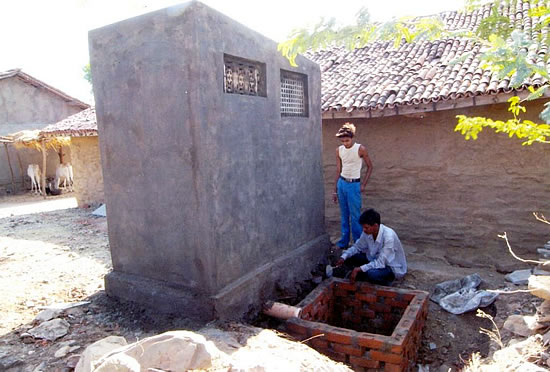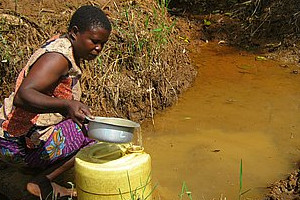O&M sanitation

In order for sanitation technologies to be truly sustainable, an operations and maintenance (O&M) plan must be considered in all stages of development. Addressing the below considerations will determine which sanitation technology choice is appropriate for your project. Several different criteria are helpful in creating a sound operations and maintenance course of action that will last for the long-term.
Technical
- Technical standards
- O&M requirements
- Availability of construction materials
- Ease of access
- Estimated lifetime
- Use for the decomposed waste
- Cost of construction
- Design preference (substructure, floor slab, squatting or raised seat, superstructure)
Environmental
- Soil texture, stability, permeability
- O&M implications for environmental protection
- Groundwater level
- Groundwater contamination
- Control of environmental pollution
- Availability of water
Institutional
- Existing national/local strategies
- Pit-emptying services (municipal/private)
- Roles and responsibilities of actors
- Sewerage maintenance capacity
- Training capacity
- Potential involvement of the private sector
- Availability of subsidies and loans
- National budget allocations for sanitation
- Availability of masons, carpenters, plumbers, sanitary
- Training and sensitization workers, diggers and persons to empty the pit
- Monitoring
Community
- Sociocultural aspects: Taboos, traditional customs, religious rules and regulations, cleansing material, preferred posture, attitude to human faeces, gender-specific requirements
- Training and sensitization
- Health awareness and perception of benefits
- Presence of environmental sanitation committee
- O&M costs
- Motivational aspects: Convenience, comfort, accessibility, privacy, status and prestige, health, environmental cleanliness, ownership behaviour
- Women’s groups
- Social mobilization on hygiene and sanitation
- Discouraging factors: Darkness, fear of falling in the hole or the pit collapsing, fear of being seen from the outside, smells, insect nuisance
- Social organization factors: Traditional role of community leaders, religious leaders, school teachers, community-based health workers
- Other factors: Population densities, limited space for latrines, acceptance of communal latrines
Low-cost sanitation technology choice

It is assumed that the technology selection process is based on a participatory needs assessment, which is carried out following an expressed demand for improved sanitation facilities. Hygiene awareness and promotion campaigns can result in an increase in the demand for improved facilities. The process of choosing sanitation technology should include at least the following steps:
- Participatory assessment of problems in the existing human excreta disposal system, as well as in hygiene behaviour, environmental hygiene and human excreta-related diseases. Participatory assessment of the cultural, social and religious influences on the disposal of human excreta and choice of sanitation technology. Participatory assessment of local conditions, convenience, capacities and resources (material resources, human resources and finance).
- Initial awareness-raising of the community on hygiene and sanitary matters—about the benefits of safe human excreta disposal and appropriate human behaviours linked to sanitation and personal hygiene.
- Identification of local preferences and capacities for sanitation facilities and possible variations. Matching these preferences with local capacities and environmental conditions including contamination risks, and determining the O&M requirements and other implications of the technology options.
- Discussions with the community about implementing different sanitation technology options and their implications in terms of operation and maintenance.
- Selection of one technology option by the community.
Improvement of sanitation facilities should be accompanied by activities in Information-Education-Communication (IEC) to promote safe sanitation behaviour and proper hygiene. These activities have a longer time horizon than the time required for improvement of physical structures. Schools and other institutions, churches, and social and community groups have an important role to promote proper hygiene and sanitation behaviour. Attention must be paid to selecting the most appropriate technology, design, and site in order to prevent environmental pollution, particularly of water resources and the living environment. Control measures must be carried out to minimize these risks.
A sampling of issues affecting the choice of O&M management models

The choice of an O&M management model is influenced by several key issues: capacity of traditional community organizations; key community skills; health education and community participation; gender-balanced development; complexity of technology; availability of spare parts; standardization and local manufacture of equipment; requirements shared with other sectors; capacity of the private sector; cost recovery mechanisms; ability and willingness to pay; national and regional economies; logistics and transportation; government leadership; strength of government agencies and staff; regional autonomy; policies and legislation; communication and information sharing.
Capacity of traditional community organizations
The community is a focal point in the management of rural WSS (water supply and sanitation) systems because it has a vested interest in efficient operation and maintenance. By their very nature, communities are structured to provide leadership, conduct social and religious activities, and attend to legal, property, and economic matters affecting their members. The control of traditional water supply sources and waste disposal sites is part of this structure, since all communities have some type of WSS facilities, however primitive these might be.
Key community skills
Among the key community skills that must be considered in assessing local management capacities are leadership, accounting, and mechanical aptitude. Leadership is required to organize, motivate, and educate the community. Many decisions require a consensus after the issues and alternatives have been clearly explained. For example, the siting of a well or standpipe could be controversial, since one location will be more convenient to some users only. The level of service and fee structures are questions that deserve wide discussion. Many water supply and sanitation (WSS) projects rely upon community participation for the construction of facilities. To marshal this work force requires leadership skills. Often communities can draw on their experience in sectors unrelated to WSS, such as building a school.
Gender-balanced development
Women are primarily responsible for obtaining and using water, but generally have not been given much say in decision-making. The result has been facility designs and management structures that hamper effective use. A gender balance of roles and responsibilities between men and women is therefore important in the design, construction, management, and utilization of WSS systems.
Complexity of technology
Technologies for rural or periurban water systems range from capped springs that feed gravity distribution systems, to deep wells equipped with electric pumps and a distribution system consisting of a storage tank and pipelines, to household connections. Sanitation systems in rural or periurban areas range from simple latrines to flush toilets with cesspools. Many of these technologies have been in use for decades with only minor changes. However, research has produced many new improvements adapted to the needs of developing countries. For example, handpumps are now designed to be more robust and easier to repair. Drilling rigs for shallow wells have been reduced in size and cost. Pumping systems relying on wind and solar energy have been developed. Low-cost latrines that are sanitary and well ventilated are now easily available.
| To read about other issues in greater detail (the above listed criteria): Towards sustainable O&M |
Field experiences
 Rwenzori Integrated School WASH Project |
 Community-led WASH and Safe Motherhood |
